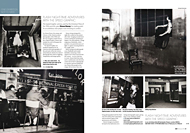My work is a combination of modern street photography combined with the look and feel of press photography from the 1940’s and 50’s.
It is very important for me to be able to work with as many of the original materials that were used during the 40’s and 50’s. The choice of film and chemicals play a crucial role in this process. The flashbulbs I use are over 70 years old, and all of my images are printed by hand in the darkroom, the majority being printed onto vintage paper originally available in the 1940’s.
Taking photographs with a Speed Graphic camera on the street is both an enjoyable and extremely challenging experience. Not only does its size make it difficult for me to go unnoticed but its weight and design can prove to be difficult if I need to take a photograph quickly. This aside, the first night I used one was not only the start of my addiction for street photography but I also found that the Speed Graphic was the only camera I could use to create the pictures I really wanted to make.
Prior to my first nights experience with the camera, I had become hooked on anything relating to vintage photography. Having been down the digital route and then back again to film, I spent the next few years playing with everything from miniature bellows cameras to Leica’s and Rolleiflex’s. During this time I still had no idea where all this was leading or for that matter what kind of pictures to take. So I took pictures of everything. Ultimately the work I produced didn’t inspire me, and it never left the darkroom.
It wasn’t until after I saw a collection of photographs taken at night by American newspaper photographers during the 1940’s that I realised what style of photography I wanted to do. I was blown away by the look and feel of the images. Every photograph seemed to share a similar quality. The subject matter in each had been illuminated by a warm circle of light and the energy, movement and tightness in the compositions was striking. I then discovered that the camera most widely used by American press photographers of that period was called the ‘Speed Graphic’ and that the ‘warm circle of light’ was due to a flashbulb being fired off when the picture was being taken.
The first question I’m asked about the camera is “Why are you using something so large and old?” The simple answer to that is because it’s fun, and somebody out there has to do it! Don’t get me wrong, it’s not the easiest camera to operate but that’s all part of the experience, and when you get it right it makes it all worthwhile. For me and the type of photography I do it’s not just about the thrill of the chase or waiting to capture that special something, that moment when everything in the viewfinder looks perfect. It’s also about the joy, or nightmare, depending on which way you want to look at it, in mastering such a cumbersome and sometimes very awkward piece of kit.
The second question is “Don’t people on the street get angry when you take their picture with that thing?” Actually I find it’s the complete opposite. The majority hardly react at all. And if for some reason I’m not fast enough to get the camera to my eye and fire off a flashbulb before they notice me, I usually just get a look of sheer disbelief. I’ve come to realise that this is because people are so unsure of what they are looking at they simply don’t know how to react.
I was once asked by a guy to “delete” a picture I had just taken of him, ok fair enough I thought. I removed the dark slide from the back of the camera, pulled out the huge negative and gave it to him. Fortunately I don’t get this kind of grief very often, in fact I’m more likely to be asked “When can we see our picture” or “Hey that’s a cool looking camera” or “What newspaper are you from” – believe it or not!
As long as they don’t stop making film, and the powers that be don’t start saying you can’t take pictures in a public place, I will carry on with my addiction.
